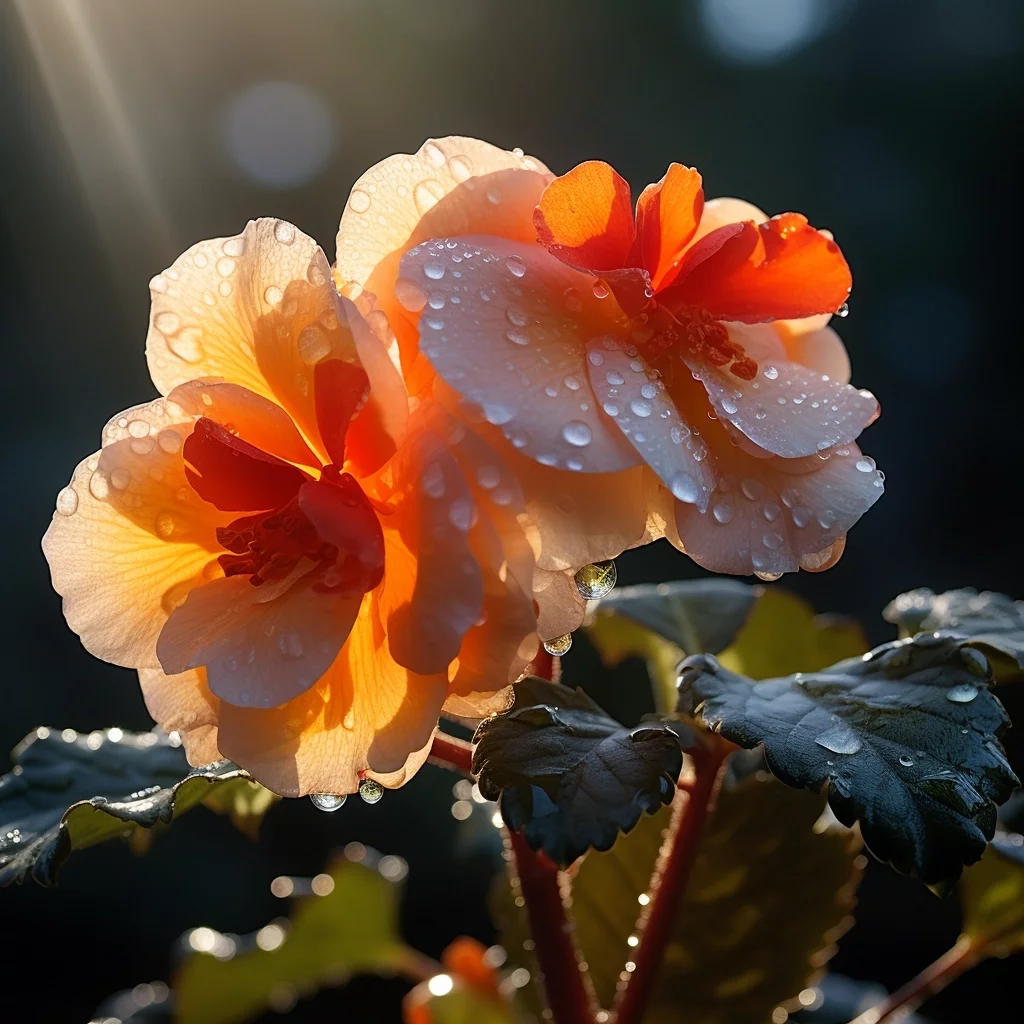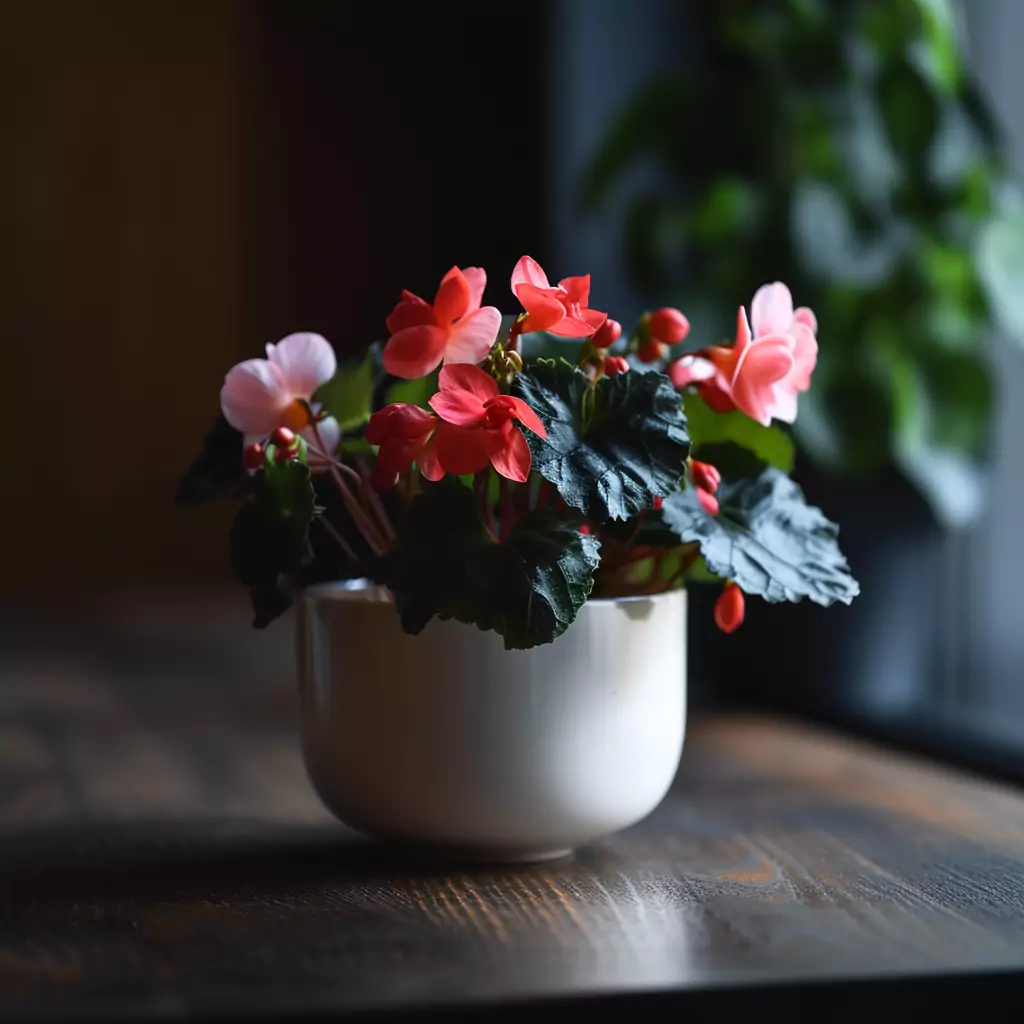Begonias, with their striking foliage and vibrant flowers, are a versatile and visually stunning addition to any garden or indoor space. This comprehensive guide delves into the specifics of caring for various begonia types, including tuberous, rex, and angel wing begonias, ensuring that these beauties thrive in your care.

Basics of Begonias: A Colorful World
Begonias, members of the Begoniaceae family, are famous for their stunning flowers and unique foliage. Originating from tropical and subtropical regions, they bring a burst of color and texture to gardens and homes.
Begonias have a rich heritage rooted in tropical climates, contributing to their preference for warm and humid conditions. This diverse genus includes over 1,800 different plant species, each with unique characteristics. Despite their varied appearances, begonias generally share common care requirements, making them a fascinating genus to explore.
From the deep green leaves and pink flowers of the wax begonia to the showy blooms of tuberous varieties, begonias are a feast for the eyes. These plants can grow up to 12 inches tall, making them ideal for window boxes, hanging baskets, and as standalone potted plants.
Common Begonia Types: An Array of Choices
Begonias, with their remarkable versatility and variety, offer a plethora of options for gardeners and houseplant enthusiasts alike. Each type brings its unique charm and specific care requirements. Let’s explore some of the most popular begonia types, highlighting their distinctive features and ideal growing conditions.
Wax Begonias: The Bedding Standout
Wax begonias, scientifically known as Begonia semperflorens, are among the most popular and widely recognized begonia varieties. Renowned for their waxy, green, or bronze leaves and clusters of small flowers, they are a staple in summer flower beds and window boxes.
- Ideal for Beginners: Wax begonias are incredibly hardy and easy to care for, making them a great choice for beginner gardeners.
- Sun and Shade Flexibility: They can thrive in both sun and shade, although they prefer a balance of the two – morning sun and afternoon shade work best.
- Color Varieties: Offering a range of colors from white, and pink, to deep red, wax begonias provide continuous blooms throughout the summer until the first frost.
Tuberous Begonias: A Burst of Elegance
Tuberous begonias, or Begonia x tuberhybrida, are celebrated for their large, showy flowers that resemble roses or camellias. They are ideal for containers, hanging baskets, and shaded garden spots.
- Spectacular Blooms: Their blooms come in a variety of vibrant colors and can be as large as 6 inches in diameter.
- Shade Lovers: Tuberous begonias thrive in filtered light and cool conditions, making them perfect for shaded patios or north-facing windows.
- Winter Dormancy: Unlike other varieties, tuberous begonias go dormant in winter. The tubers can be stored and replanted each spring.
Cane Begonias: Angel Wings and More
Cane begonias, known for their bamboo-like stems, include the popular ‘Angel Wing’ begonias and ‘Dragon Wing’ begonias. They are cherished for their foliage as well as their flowers.
- Unique Foliage: Their leaves can be variegated and often have a wing-like shape, hence the name ‘Angel Wing’.
- Flowering Habit: These begonias produce clusters of dangling flowers in shades of pink, white, or red during the warmer months.
- Indoor and Outdoor Versatility: They can be grown outdoors in summer and then brought indoors for winter, making them a versatile choice for year-round interest.
Rhizomatous Begonias: The Foliage Kings
Rhizomatous begonias are primarily grown for their interesting and often dramatically patterned leaves. They grow from thick rhizomes and can vary significantly in leaf shape and color.
- Diverse Leaf Shapes and Textures: Their leaves can range from small and round to large and heart-shaped, with textures from smooth to hairy.
- Subtle Bloomers: While their flowers are more understated, they add a delicate charm to the plant’s appearance.
- Perfect as Houseplants: These begonias are excellent for indoor cultivation, thriving in bright, indirect light and high humidity.
Rex Begonias: The Showstoppers
Rex begonias are a subgroup of rhizomatous begonias, known for their spectacular foliage. Their leaves boast vibrant colors, intricate patterns, and a variety of textures.
- A Palette of Colors: The foliage can include a mix of silver, green, red, pink, and even purple, making them stand out in any indoor plant collection.
- Light Requirements: They prefer bright, indirect light but can be sensitive to too much direct sunlight.
- Humidity is Key: High humidity is crucial for Rex begonias, making them well-suited for terrariums or well-lit bathrooms.
By choosing the right type of begonia for your space and providing the specific care it needs, you can enjoy the diverse beauty and charm these plants bring. Whether you prefer the lush flowers of tuberous begonias, the striking leaves of Rex begonias, or the easy-care nature of wax begonias, there is a begonia to suit every taste and gardening style.
Planting Begonias: The Right Start
Post-Frost Planting
Plant your begonias after the last frost date in your area. These plants are sensitive to cold temperatures and will thrive best when the threat of frost has passed.
Choosing the Perfect Spot
Select a location that receives partial shade or filtered sunlight for your begonias. While some types like the wax begonia can tolerate full sun, most begonias do best in morning sun and afternoon shade. Ensure good air circulation to keep powdery mildew at bay.

Begonia Care: Tips for Thriving Plants
Watering and Soil Needs
Regular watering is vital, but it’s crucial to let the soil dry out slightly between waterings. Begonias prefer well-drained soil that remains moist but not waterlogged. Overwatering can lead to root rot, a common issue with these plants.
Pruning and Maintenance
Different types of begonias require varied pruning methods. For example, pinching back the stems of wax begonias encourages bushier growth. In contrast, rex and tuberous begonias may need less frequent pruning.
Overwintering Begonias
In regions with colder weather, it’s best to dig up tuberous begonias and store them inside during the winter. Meanwhile, you can bring varieties like rex and cane begonias indoors and keep them as houseplants during the colder months.
Growing Begonias Indoors: A Lush Addition
Challenges and Rewards
While growing begonias indoors can present challenges, many varieties, particularly rex and angel wing begonias, thrive in indoor environments. Control water levels to avoid overwatering and ensure your plant is placed in a location that receives ample light, such as east-, west-, or south-facing windows.
Potting and Repotting
Choose pots with adequate drainage holes for your indoor begonias and consider repotting only when necessary. Repotting should be done with care, using fresh, well-drained soil to promote healthy growth.
Begonia Varieties: Exploring the Options
Begonias come in numerous varieties, each offering something unique. From the bushy growth of semperflorens begonias to the striking flowers of tuberous types, there’s a begonia to suit every gardener’s preference. Understanding the specific needs of each type, from the amount of light to the watering schedule, is key to successful begonia care.
Pest and Disease Management
Keep an eye out for common pests like mealybugs and practices such as not letting the soil remain too moist can prevent most insect problems. Regularly check your plants and address any issues promptly to keep your begonias healthy.
The key to thriving begonias is understanding their needs and providing consistent care. Whether it’s ensuring the soil feels dry to the touch before watering, providing bright but indirect light, or pruning correctly, each step plays a role in the health of your begonia.🌿🌺💧

Begonia FAQ: Everything You Need to Know About These Diverse Beauties 🌺
1. What Are the Different Types of Begonias?
Begonias come in various forms, including the angel wing begonia, known for its wing-shaped leaves and pale pink flowers. The genus Begonia includes over 1,800 species, with variations like tuberous, fibrous, and rhizomatous begonias. Hardy begonias can withstand cold climates, while other types are grown as annuals or perennials, depending on the climate zone.
2. Can Begonias Grow Both Indoors and Outdoors?
Absolutely! Begonias are versatile and can be grown indoors as houseplants or outdoors as part of garden beds. Indoors, they prefer bright, indirect light, while outdoor varieties thrive best in partial shade. Angel wing begonias and rhizomatous begonias, for instance, are particularly popular as houseplants.
3. How Do I Care for Begonias?
To care for beautiful begonias, plant them in well-drained soil and place them in an area with suitable light. Most begonias grow best in partial shade, although some can tolerate sun or shade. Watering needs vary; generally, allow the soil to dry slightly between waterings.
4. Are Begonias Easy to Grow?
Yes, begonias are generally easy to grow. They are adaptable and can thrive in a range of environments. The key to success is understanding the specific needs of the begonia species you choose, whether it’s a bushy bedding plant or an elegant angel wing begonia.
5. What Are the Best Conditions for Flowering in Begonias?
To encourage begonias to flower, they need bright light but not direct, scorching sunlight. The flowering varieties, like the tuberous begonias, often produce flowers in shades of red, pink, or white and do best with morning sun and afternoon shade. Fertilize regularly during the growing season for continued blooming.
6. Can Begonias Be Propagated Easily?
You can propagate many begonias using leaf cuttings or divisions. For instance, to multiply an angel wing begonia, just cut a piece of leaf and stem and plant it in moist soil. You can also divide rhizomatous begonias and replant them to grow new plants.
7. How Often Should Begonias Be Repotted?
Repot begonias when they outgrow their containers or become root-bound, usually every 2-3 years. During repotting, use fresh, well-drained soil and handle the delicate roots with care.
8. Do Begonias Prefer Containers or Ground Planting?
Begonias are versatile. Many types, such as compact fibrous begonias, thrive in containers, while others make great bedding plants in gardens. For container plants, use well-drained pots and water regularly.
9. How Tall Do Begonias Grow?
The height of begonias varies significantly among species. While some fibrous begonias might only grow 8 to 10 inches tall, cane begonias like the angel wing can reach several feet in height.
10. What Are Common Challenges When Growing Begonias?
Common challenges include managing the right amount of light and water. Overwatering can lead to root rot, and too much direct sunlight can scorch the leaves. Begonias also need protection from frost and prefer consistent temperatures.
11. Are There Any Pests or Diseases That Affect Begonias?
Begonias may face issues like powdery mildew, especially if air circulation is poor. They can also be affected by pests such as aphids and mealybugs. Regular inspection and maintaining healthy growing conditions can keep these problems at bay.
Megan Stewart, a houseplant aficionado and biologist, resides in the city of Portland, Oregon, USA. Her passion for greenery is matched only by her academic prowess; Megan holds a degree in Biology from the University of Oregon. This background has provided her with a rich understanding of the biological intricacies of plant life, which she skillfully applies to her collection of indoor plants.
Megan's home is a testament to her love for all things green, filled with a diverse array of houseplants ranging from exotic orchids to robust succulents. When she's not tending to her indoor garden, she spends her time with her beloved pets, a constant source of companionship and joy. Her articles are a reflection of her life's passions, offering readers a blend of practical plant care advice, and insightful biological tidbits.
Through her writing, Megan aims to inspire others in the USA and beyond to create their urban jungles and foster a deeper connection with nature.


